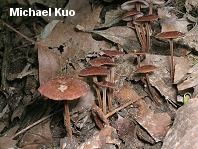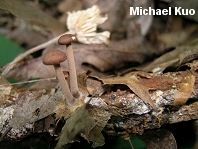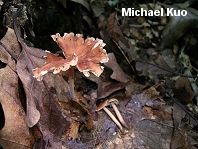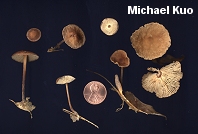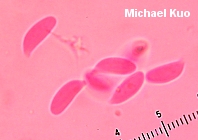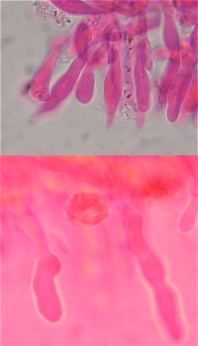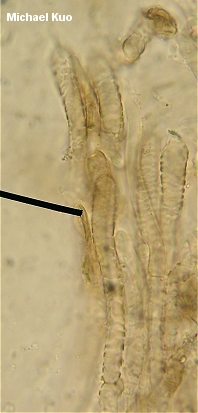| Major Groups > Gilled Mushrooms > Pale-Spored > Collybioid > Gymnopus subnudus |

|
Gymnopus subnudus [ Basidiomycetes > Agaricales > Marasmiaceae > Gymnopus . . . ] by Michael Kuo Gymnopus subnudus, also known as Collybia subnuda, is definitely an LBM ("Little Brown Mushroom")--and not a very thrilling one, at that. Microscopic examination is probably required to identify it with certainty (see the details below), but its habitat on leaf litter, wrinkled brownish cap with a widely lined mature margin, distant or subdistant gills, and frequently bitter taste help narrow down the possibilities. Gymnopus dichrous is a dead ringer for Gymnopus subnudus--but it grows from sticks, logs, and stumps (rather than leaf litter) and features different cheilocystidia. Mating studies done by Murphy (1997) determined two groups of Gymnopus subnudus in eastern North America that were incapable of mating, despite sharing similar morphology and nearly identical DNA sequences. Description: Ecology: Saprobic; growing scattered, gregariously or in loose clusters on the leaf litter of oaks and other hardwoods; late spring through fall; eastern North America from Maine to Illinois. Cap: 1-5 cm; convex with an incurved margin when young, becoming broadly convex, flat, or shallowly depressed; dry; fairly bald; cinnamon brown to dark brown or reddish brown when young and fresh, fading to pinkish tan; usually becoming somewhat wrinkled and developing a broadly lined margin; in old age or in dry conditions often splitting radially and/or becoming contorted. Gills: Attached to the stem, or nearly free from it by maturity; distant or nearly so; whitish when young, darkening to pinkish buff. Stem: 2-7 cm long; up to about 3 mm thick; more or less equal, but usually flaring at the apex; dry; tough; bald above; finely hairy or finely velvety below; buff, darkening to brownish, reddish brown, or nearly black near the base. Flesh: Whitish to brownish; thin; tough. Odor and Taste: Odor not distinctive; taste not distinctive, or bitter. Chemical Reactions: KOH olive on cap surface. Spore Print: Creamy white. Microscopic Features: Spores: 8-11 x 3-4.5 µ; smooth; lacrymoid to elliptical; inamyloid. Pleurocystidia absent. Cheilocystidia up to about 40 x 9 µ; variously shaped (cylindric, fusiform, fusoid-ventricose, mucronate); sometimes lobed or diverticulate. Pileipellis a tangled cutis of cylindric elements 3-8 µ wide, frequently encrusted (in bands or spirals) with brownish pigment in KOH. REFERENCES: (Ellis ex Peck, 1898) Halling, 1997. (Saccardo, 1902; Kauffman, 1918; Halling, 1983; Halling, 1997; Murphy, 1997; Barron, 1999; Halling, 2004.) Herb. Kuo 06010402, 08160501, 09270502, 07120809, 06171005, 09161201. This website contains no information about the edibility or toxicity of mushrooms. |
© MushroomExpert.Com |
|
Cite this page as: Kuo, M. (2013, January). Gymnopus subnudus. Retrieved from the MushroomExpert.Com Web site: http://www.mushroomexpert.com/gymnopus_subnudus.html |
